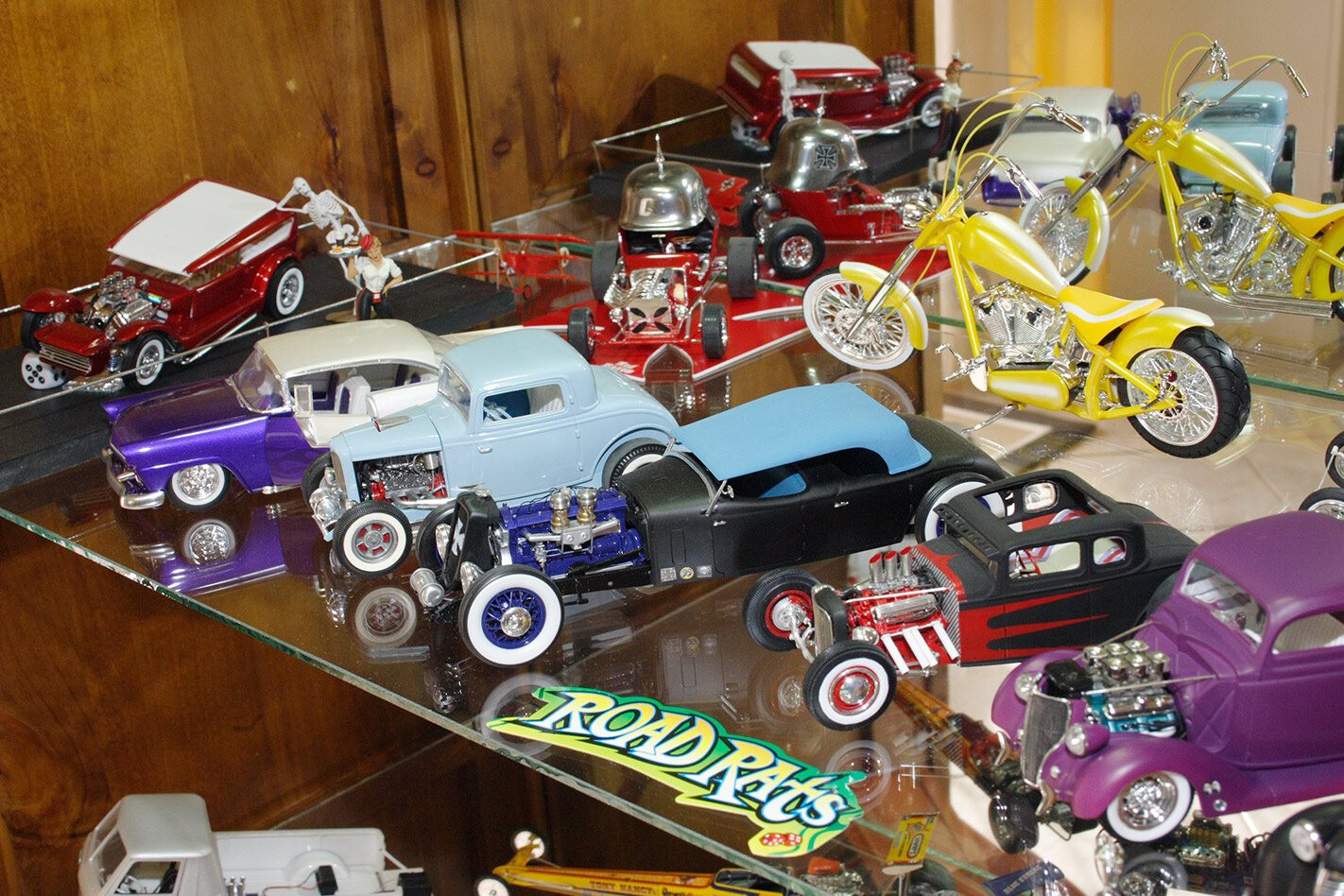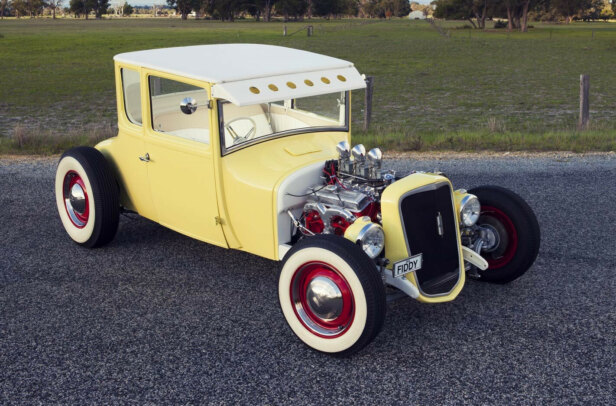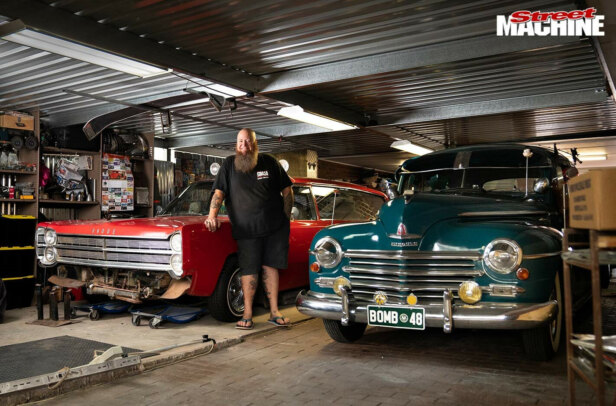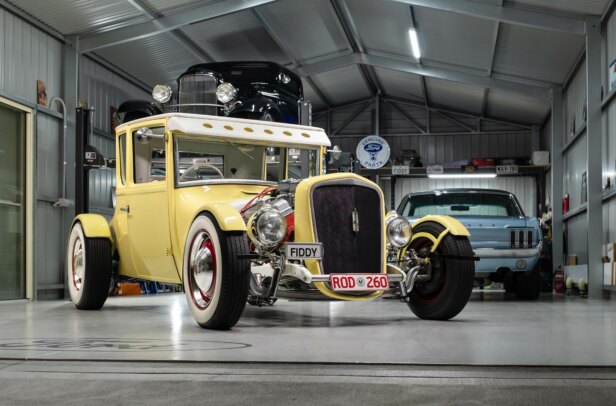Dave Loye’s shed is a bit smaller than some we’ve featured. But then, so are his cars
This article on Dave’s model cars was originally published in the June 2009 issue of Street Machine
IT ISN’T the biggest shed we’ve ever featured. In fact, it’s not really a shed, but what Dave Loye creates in the cosy confines of his suburban Perth home is quite amazing. Everything from your standard ’32 Ford hot rod to scratch-built Aussie drag cars, the man’s talents are many and varied.
Although the smaller stuff is his focus these days, plenty of 1:1 scale cars have graced his driveway.
“I’ve owned about 70 cars — the usual range of hot Holdens and Fords. Had a bit of a passion for HR Holdens — had four of them — and I had quite a nice 265 Hemi Valiant. I’m a bit of a Ford man, though.”
Dave’s roll-top desk is the perfect working environment for building models. All of his tools are close at hand and when he’s done for the night, he shuts the lid and the mess disappears
The model bug bit pretty early, thanks to an enthusiastic and car-loving father.
“Dad introduced me to modelling when I was five or six. A slot-car track opened in a local shopping centre; it was one of the first tracks in Melbourne. We used to hire the slot cars. We bought a couple of model kits to convert into slot cars, which is what you did in those days. I think my first model was a 60s Honda F1 car.”
The modelling was a pretty big thing up to his early teens, when the usual distractions arose. “The real cars came along and I got into them but when kids come along, you’re not financial enough to have a big garage full of real cars, so you take out your full-size frustrations by building models.”
Dave uses a Clisby hobby lathe to turn up pieces such as blower pulleys, tachos, fuel tanks and even wheel rims
After completing his mechanical apprenticeship, Dave jumped into the spare parts industry but still got his hands dirty after-hours. ”I ran my own business part-time doing custom engine bays. It involved performance engine rebuilding, engine and engine bay detailing. I even did a re-conversion on a ’69 Mustang 428 Super Cobra Jet — putting it back to RHD from a really bad conversion. This car had hammer holes through the heater box to get the shafts through for the pedals.
“I’ve always been involved with cars in some way. I was lucky in that Dad used to take me to a lot of racing. He liked cars and bikes. I met Sir Jack Brabham and Bib Stilwell, watched Allan Moffat and Ian Geoghegan race in the 60s, the Can-Am series and that stuff.”
Dave had a go at racing too. “When I was a late teenager, me and a mate got interested in speedway and I campaigned a Super Modified for a couple of seasons until I ran out of money [laughs]. It had a 327 with McGee fuel injection. That was a bit of fun.”
An old Ikea cupboard is the perfect spray booth. The white finish means there’s plenty of light and Dave recommends a good quality pressure regulator. Once the painting is done, shut the doors so no dust gets in
Looking at Dave’s extensive collection of models, what’s striking is the diversity. There are hot rods and customs, wild show rods, famous TV cars, speedway and circuit racers, plus drag cars of every description.
The most impressive are the ones you can’t buy off the shelf. Models like Graham Withers AMPOL G-T dragster, the Cowin & Johns ‘Psycho III’ or the wild Shaker Monaro Funny Car. They’re pretty famous if you’re an Aussie drag racing fan but you won’t find them at your local hobby shop.
Dave doesn’t just build stuff because it’s famous; he’ll build a model just because he likes the look of it or he saw it race somewhere. For example, the wild FC, ‘Road Rattler’, was built from a single photo he found in an old magazine. You’ve gotta love the sign-writing on the front guard: Owner. Driver. Mechanic — Bill Barclay. Don’t see that too often now!
A good tip for young modellers: separate all of the parts that need to be painted the same colour onto Styrofoam blocks
Although he hasn’t had a chance to play with any full-size cars lately, the models have allowed Dave to keep his love of building cool rides going.
“I’ve done what I’ve done out of a desire to build cars that you can’t get in kits. The same passion I had for customising real cars I enjoy doing in models. It’s a lot easier but you use different techniques than you would on a real car, such as panel work and spray painting.”
Dave adds a lot of realism to his models, which is easier these days thanks to the range of resin and photo-etched parts you can buy, but he still likes to come up with his own solutions to get the little details right.
“In the early days, when the kids were young, I couldn’t afford to buy aftermarket resin parts. I had to work out a way to scratch-build my own Scott injector, improvising and using different things to achieve a realistic result. Getting a piece of solder and rolling a file over it, you can imitate a piece of braided piping. You’re always looking for things that you can use. I reckon the best automotive hobby outlets are Spotlight craft shops; they’ve just got so much stuff.”
He has a selection of airbrushes now but for a long time got by with the $25 Testors cheapie in the grey box. The full-size touch-up gun (far right) is for larger 1:12 and 1:16 models
Dave may have gone a little bit too far, getting the hobby lathe, but the results are cool.
“I bought the lathe purely so I could make more realistic engine parts, fuel tanks and all sorts of bits and pieces like that. The parts are too small to do on a full-size lathe — I tried and it didn’t work. If you want to make something small, you’ve got to use small tools.”
The cars in this shed might be 25 times smaller than the ones you usually see in SM but just as much passion has gone into building them as any ride we’ve featured.
SOME OF DAVE’S CARS
1. This D/MP FC Holden was created from a single photo using a resin model from thepartsbox.com. It really captures the spirit of early 70s drag racing on a budget
2. Dave used to buy parts from Graham Withers Speed Shop but it was the Scott injector hat on the rail — like the Mad Max car — that attracted him to this
3. Dave’s a Batman fan and made this cool Batmobile from a Lincoln Futura kit, just like George Barris did. The matching dragster is out of Dave’s imagination and was based on a T’rantula kit
4. The entire chassis for the Shaker was scratch-built from brass tubing, while the resin body from Cavalier was chopped. Don’t go looking for these decals — the wild paisley pattern was drawn up on a computer, while the lettering was printed on white decal film, which meant painstakingly cutting around each letter!
5. For a bit of a laugh, Dave built ‘King Kammer’, an imaginary A/FX Falcon based on the Daddy Warbuck’s kit. It’s fairly stock except for the injection and wheels off the ‘Munster Koach’
6. These rear wheels look real because Dave made aluminium rims on the lathe. The spokes are beads cut in half and reshaped — all up, there are 17 parts making up the wheel!
7. Wayne Ruckley’s ‘Cheetah II’ was featured in CIG ads back in the day but it was those mile-high injector hats that grabbed Dave’s attention. Dave tracked Wayne down to get details of the car
8. This 1:12 scale ’57 Chevy copped full airbags and custom-mixed orange pearl paint. Dave even drilled all of the bolts on the engine and chassis and replaced them with shiny pinheads




Comments